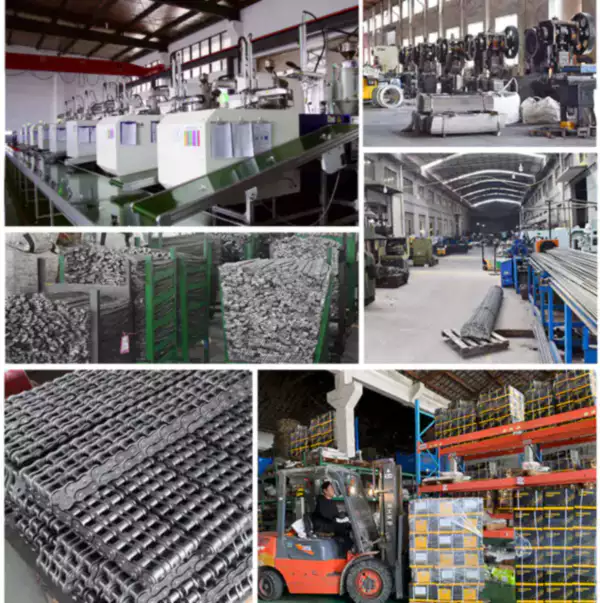Introduction
Silent chains, also known as inverted tooth chains, are an essential component in various industrial applications. These chains are widely used in power transmission systems due to their high efficiency and low noise levels. In order to ensure the quality and performance of inverted tooth silent chains, rigorous testing protocols are employed. This article will explore the testing protocols used for evaluating inverted tooth silent chains, providing a comprehensive understanding of the testing methodologies employed in the industry.
1. Material Analysis
1.1 Chemical Composition
The first step in evaluating inverted tooth silent chains is to conduct a thorough material analysis. The chemical composition of the chain's components plays a crucial role in determining its mechanical properties and overall performance. By employing advanced spectroscopic techniques, such as X-ray fluorescence (XRF) analysis, the exact composition of the chain's materials can be determined.
1.2 Microstructure Analysis
In addition to chemical composition, the microstructure of the chain's components is also analyzed. Microscopic examination, using techniques like optical microscopy and scanning electron microscopy (SEM), allows for the assessment of grain boundaries, phase distribution, and any potential defects or impurities present in the material.
2. Mechanical Testing
2.1 Tensile Strength
Tensile strength testing is performed to determine the maximum load a chain can withstand before breaking. This test helps assess the chain's resistance to external forces and ensures its durability under various operating conditions.
2.2 Fatigue Testing
Fatigue testing is crucial to evaluate the chain's resistance to repeated stress cycles. By subjecting the chain to cyclic loading conditions, often using a fatigue testing machine, its fatigue life can be determined. This test helps identify potential failure points and ensures the chain's reliability over an extended period of time.
2.3 Wear Testing
Wear testing is conducted to assess the chain's resistance to abrasive forces. Various techniques, such as pin-on-disc or block-on-ring, are employed to simulate the chain's interaction with other components. This test helps evaluate the chain's wear characteristics and its ability to maintain performance under abrasive conditions.
3. Performance Testing
3.1 Noise Level Measurement
One of the key advantages of inverted tooth silent chains is their low noise emission. To ensure the chain meets the desired noise level requirements, sound level measurements are conducted using specialized equipment. This test helps assess the chain's noise performance and confirms its suitability for noise-sensitive applications.
3.2 Efficiency Analysis
Efficiency testing is performed to evaluate the chain's ability to transmit power with minimum energy loss. By measuring input and output power, along with rotational speed, the chain's efficiency can be calculated. This test helps identify any potential areas for improvement and ensures optimal power transmission.
4. Sprockets for Silent Chains
Silent chain sprockets play a vital role in the operation of inverted tooth chains. These specially designed sprockets ensure smooth engagement and disengagement of the chain, minimizing noise and increasing overall efficiency. The compatibility between silent chain sprockets and inverted tooth chains is crucial for optimal performance and longevity. At RP Techniek BV, we offer a wide range of high-quality silent chain sprockets that complement our inverted tooth chains. Our silent chain sprockets are meticulously engineered to provide a perfect fit and reliable performance.

About Us
RP Techniek BV, the Dutch sales agent of Ever-power Group, is a leading supplier of silent chains in the market. Our commitment to providing competitive prices and excellent service has made us a preferred choice for customers worldwide. With over 90% of our products exported to the United States, Canada, Japan, South Korea, Brazil, Australia, and other markets, we strive to meet our customers' needs with high-quality products. As a reputable chain manufacturer, we have a strong focus on innovation and continuously improving our offerings.

Q&A
Q1: What are the main advantages of inverted tooth silent chains?
A1: Inverted tooth silent chains offer several advantages, including high efficiency, low noise levels, and excellent wear resistance. These chains are also known for their durability and ability to transmit high power.
Q2: Can inverted tooth silent chains be used in high-speed applications?
A2: Yes, inverted tooth silent chains are suitable for high-speed applications. Their design reduces vibration and noise, allowing for smooth and reliable operation even at high rotational speeds.
Q3: How do silent chain sprockets contribute to the overall performance of inverted tooth chains?
A3: Silent chain sprockets provide precise engagement and disengagement of the chain, ensuring smooth power transmission and minimal noise generation. Properly matched sprockets enhance the overall efficiency and longevity of the inverted tooth chains.
Q4: What lubrication is recommended for inverted tooth silent chains?
A4: It is recommended to use a high-quality lubricant specifically designed for inverted tooth silent chains. The lubricant should offer excellent adhesion properties, corrosion protection, and resistance to high temperatures.
Q5: Can inverted tooth silent chains be used in corrosive environments?
A5: Yes, inverted tooth silent chains can be used in corrosive environments. However, it is essential to select the appropriate material and apply suitable protective coatings to enhance their corrosion resistance.
Edited by: Zqq.
